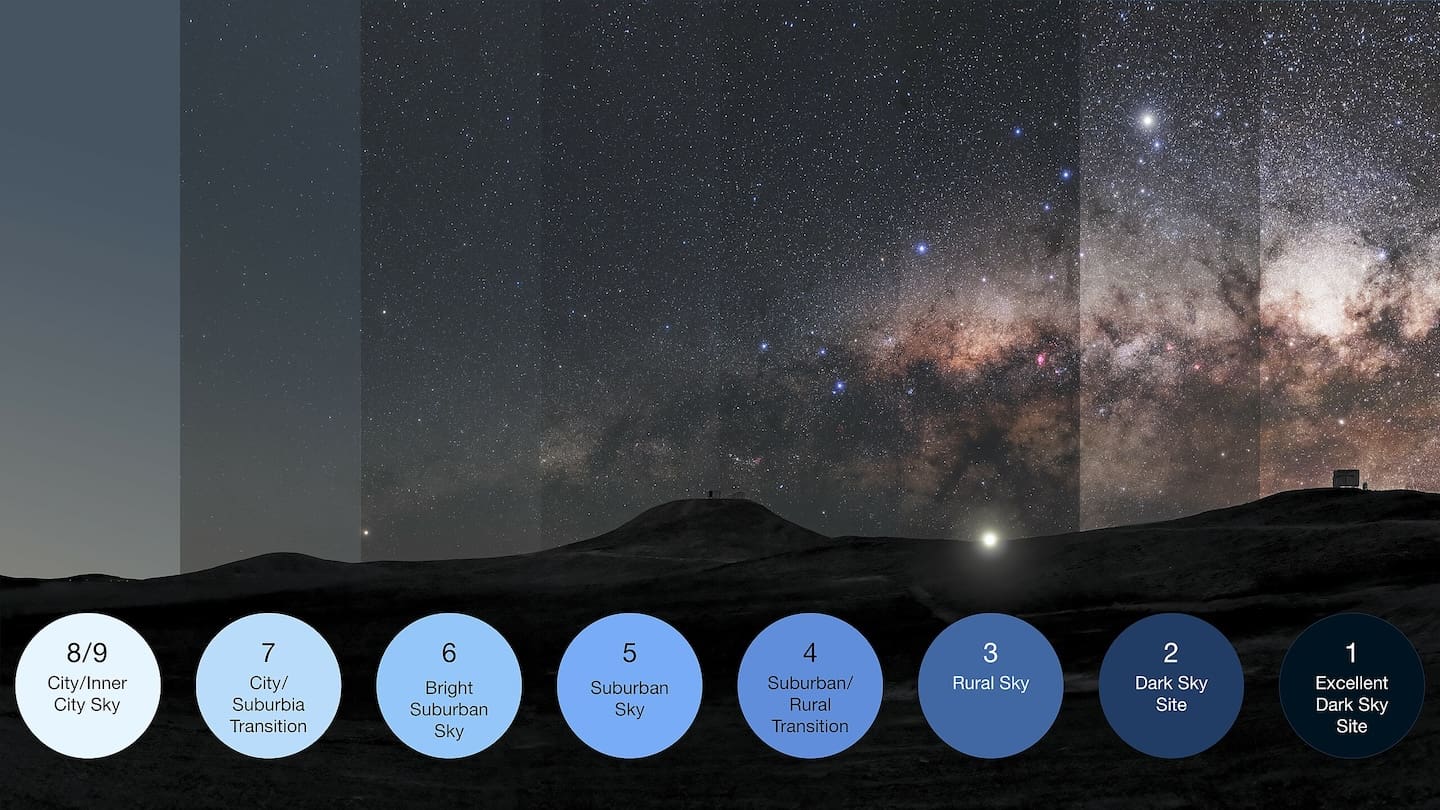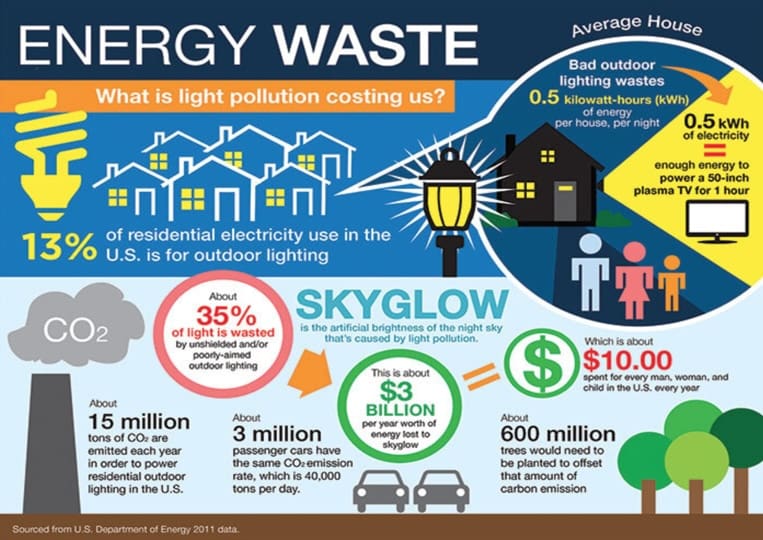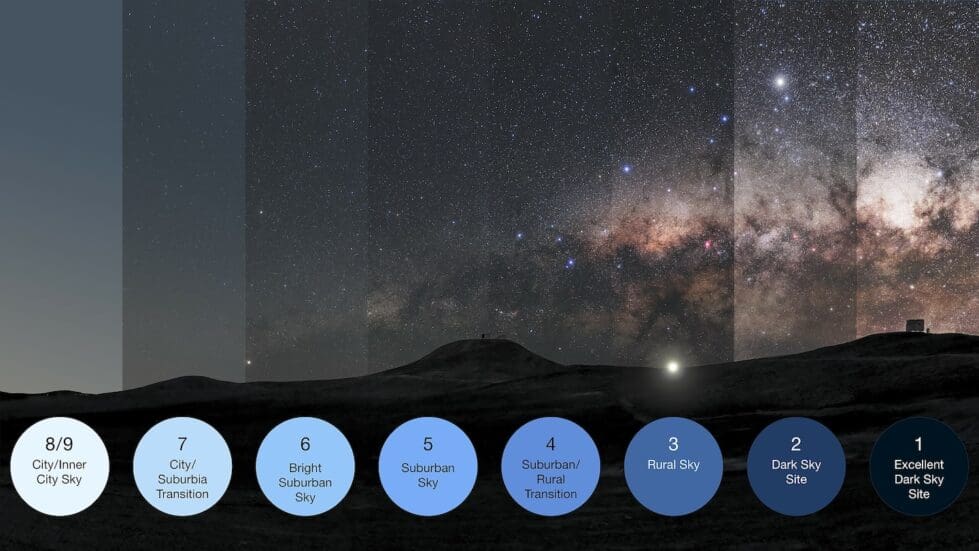
This image shows the increasing visibility of stars and night-sky objects in excellent dark sky conditions compared with cities. It modifies a photo taken at ESO’s Paranal Observatory in Chile, a place perfect for astronomy. European Southern Observatory.
Light pollution was on many Delawareans’ minds in mid-May as they sought dark places to observe the northern lights.
And a few days later New Castle County Council unanimously approved an ordinance to reduce light pollution.
“Ordinance 23-122 only affects new commercial construction projects (or significant redevelopment projects), and at its most basic simply ensures that light and energy is not wasted by having fixtures which allow light to go above more than 90 degrees to the ground,” council member Dee Durham wrote in her newsletter.
The ordinance follows an ordinance that she spearheaded a few years to to require new development streetlights to be comply with a concept called Dark Skies.
“The goal was to align the County’s code to the extent possible with the recommendations of the Pennsylvania Outdoor Lighting Council and DarkSky International which seeks to advance responsible outdoor lighting as light pollution disrupts wildlife, impacts human health, wastes money and energy, contributes to climate change and blocks our view of the universe,” she continued.
For an example of a project that complies with dark skies, she offered Barley Mill, a newish mixed-use development on Route 141 that’s anchored by Delaware’s only Wegmans market.
“All of the parking lot lighting there is Dark Skies compliant – with full cutoff fixtures, where the light cannot go above 90 degrees to the ground,” she said.
The ordinance also says that spotlights and floodlights “shall be screened by walls, berms and/or cutoff shielding so the light source is not visible off site.” Evergreen landscaping is not an option.
When asked about how street lights affect safety, she sent along an email chain from when the bill was discussed in March.
“Ultimately, the ordinance does not change how much light there is on pathways, walkways, parking lots, around buildings, parks – it simply is geared toward not having light go up where it serves no purpose, and on the contrary, has many negative impacts,” she wrote. “The safety factor is not changed. But the benefits, especially over time, could be significant.”
“It is hard for us to make an assessment without seeing the difference; however, I’m not even sure lights are something that deters crime anymore,” Joseph S. Bloch, the county’s chief of police wrote to her, adding that based on what she wrote, “the Division of Police would not be opposed to this ordinance.”
The ordinance also had the support of the county planning board, the county land use department and a state review system called preliminary land use service, she said.
Her newsletter and this report include a photo comparing the view of various types of communities, from the center of a city to an excellent Dark Sky. The photo is available on multiple websites, including the International Astronomical Union and is credited to the European Southern Observatory.

The International Dark Sky Association created this graphic about light pollution from U.S. Department of Energy data.
The cost of light pollution
Her newsletter and this report also include a graphic credited to the International Dark Sky Association, which uses U.S. Department of Energy data to conclude that light pollution costs about $3 billion a year, or about $10 for each America.
“Improved lighting as 23-122 intends means placing the light only where it is needed or wanted, and preventing light trespass and sky glow,” she wrote in her newsletter. “The ordinance should decrease wasted resources, no longer have the code depend on vegetation to address light pollution between neighbors, and begin to address LED luminaire output which is too bright or ‘cold.’”
Her email also contains this passage:
The Illuminating Engineering Society uses the terms safety and security as follow:
Safety is freedom from danger.
Security is a feeling of safety.
The Myth: “Security Lighting will reduce crime in urban outdoor areas.”
A 1997 National Institute of Justice report to Congress said, “- – the effectiveness of lighting [as a crime deterrent] is unknown.” Results are mixed. We can have very little confidence that improved lighting prevents crime, particularly since we do not know if offenders use lighting to their advantage.”
We may speculate that lighting is effective in some places, ineffective in others, and counter-productive in still other circumstances. The problematic relationship between lighting and crime increases when one considers that offenders need lighting to detect potential targets and low-risk situations (Fleming and Burrows 1986). Consider lighting at outside ATM machines, for example. An ATM user might feel safer when the ATM and its immediate surrounding area are well lit. However, this same lighting makes the patron more visible to passing offenders. Who the lighting serves is unclear.”
Share this Post



